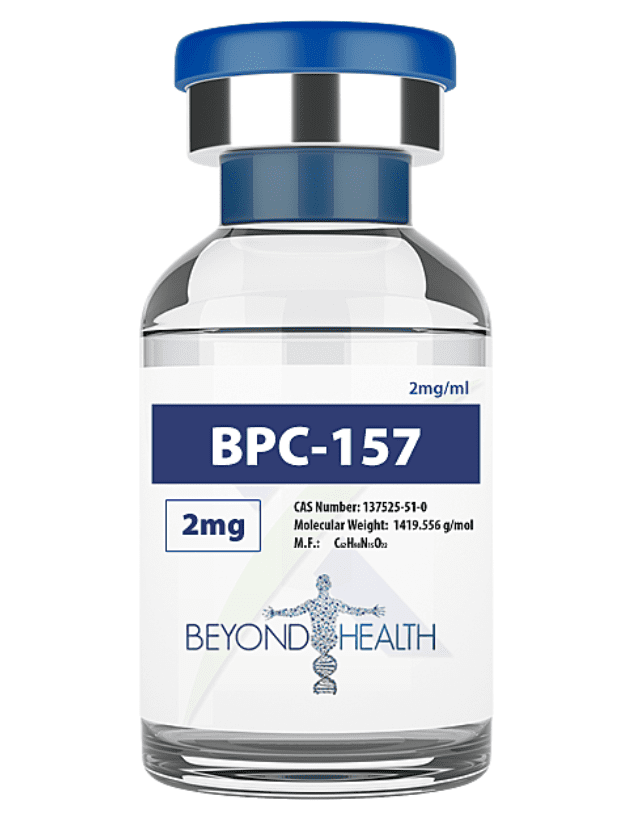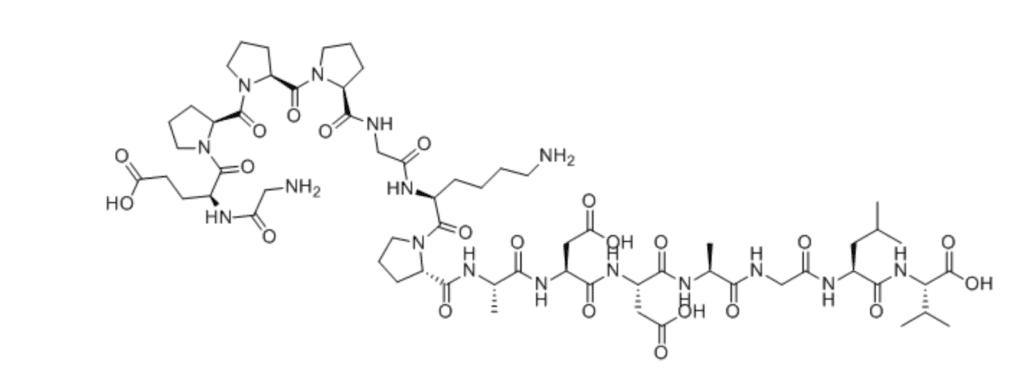In addition to its conventional medical uses, athletes and the specialists who treat them are increasingly interested in the performance-enhancing and recovery-speeding benefits of this potentially revolutionary peptide.
You may have heard of BPC-157 if you have spent time in the athletic world – and for good reason. This peptide has been studied clinically in terms of its effect on human health since 1991, with intensified interest in recent years for applications ranging from injury recovery to improved performance in athletes.

Here, we’ll take a science-based deep dive into the details of this supplement to explore what it may do for you.
What Is BPC-157?
The BPC-157 compound – also known by its chemical moniker C62H98N16O22 – is a short-chain amino acid sequence. It is comprised of 2 atoms of carbon, 98 atoms of hydrogen, 16 atoms of nitrogen, and 22 atoms of oxygen.
Short-chain amino acids such as BPC-157 are often referred to as simply “peptides.”

What Are the Potential Applications of BPC-157 For Recovery and Optimized Performance?
Due to its natural healing properties in the gut, BPC-157 is often used to effectively treat inflammatory bowel disease (IBD), stomach ulcers, and other conditions affecting the gastrointestinal tract:
“Stable gastric pentadecapeptide BPC 157 (GEPPPGKPADDAGLV, M.W. 1419) may be… effective both in the upper and lower GI tract, and free of side effects. BPC 157, in addition to an antiulcer effect [is] efficient in therapy of inflammatory bowel disease (IBD).”
Other potential uses of BPC-157 – again, all backed by extensive clinical research spanning three decades — in traditional medicine include:
- Preventing and possibly reversing drug-induced damage to the gut lining caused by NSAIDs
- The treatment of periodontal (gum) disease (proof of concept successfully demonstrated in rat study)
- Reversal of corticosteroid-induced muscle damage
- Tamping down of systemic inflammation
- Treatment of traumatic brain injury, multiple sclerosis, and other neurological illnesses and injuries
The novel uses of BPC-157 for athletes include its vast, and yet-untapped, application for fueling the repair of multiple tissues throughout the body that may be damaged due to intensive training:
“Currently, all studies investigating BPC 157 have demonstrated consistently positive and prompt healing effects for various injury types, both traumatic and systemic and for a plethora of soft tissues… it is apparent that BPC 157 has huge potential and following further development has promise as a therapy to conservatively treat or aid recovery in hypovascular and hypocellular soft tissues such as tendon and ligaments.”
BPC-157 increases the rate of bone healing following a fracture, as demonstrated in a profoundly important (in terms of healthcare applications for humans) rabbit study:
“BPC-157, improves wound and fracture healing in rats in addition to having an angiogenic effect… following other pentadecapeptide BPC-157 regimens (local application, or intermittent intramuscular administration), the number of animals with healed defect was increased.”
Essentially, what the science tells us is that whether the injury is a broken bone or a torn ligament, BPC-157 has the proven capacity to get athletes back into full-speed action faster – an advantage which, as any competitor can attest to, is a game-changer.
What Is the Optimal Dosage For Enhanced Athletic Performance?
The generally accepted ideal dosage of BPC-157 is 1-10 micrograms (mcg) per kilogram of body weight. This means, for the average man, a daily regimen of somewhere in the range of 200-800 mcg. Many users get the best response by splitting this daily intake into two doses, one in the morning and one in the evening.
As with any supplements, best practices generally indicate that you begin at the lower end of the scale and gradually titrate up the dosage as necessary, monitoring for any adverse reactions until you discover your optimal individual range.
What Is the Ideal Administration Route for BPC-157?
BPC-157 comes in two common forms:
- Capsules for oral administration
- Injectable for subcutaneous administration
What Is the Safety Profile of BPC-157?
It’s always wise to look out for any potential negative side effects of supplements, especially in the rapidly evolving world of sports supplements.
BPC-157, due to its presence in the human gut, is exceptionally well-tolerated when administered at optimal doses. There is no toxicity associated with the use BPC-157.
Best of all for athletes in competition, BCP-157 is currently allowed under World Anti-Doping Agency (WADA) regulations as this healing compound is not (yet) included in the list of banned substances. Accordingly, if you are set to compete, you need not worry about sanctions for use of this peptide.
What Do Actual BPC-157 Users Have to Say About Their Experiences?
Understandably, reading the clinical literature is one thing; seeing the benefits of BPC-157 in action is another. What do the athletes who use BPC-157 have to say?
Reddit user u/DivisibleZero writes, in a post titled BPC 157 is living up to the hype:
“I was very skeptical about BPC 157 and peptides in general. But after doing some research there seemed to be something there… I’ve been taking it for 10 days now and I’ve been blown away with the effectiveness. My shoulder is feeling significantly better and I noticed improvements in range of motion 3 days in. At 10 days now the impingement on my nerve is almost gone and the pain which used to radiate down my arm is now minor and localized. An old hamstring injury that I had accepted wasn’t going to get better a year ago has seen improvement as well. Stability and power in my squats and lunges has increased.”
Similar personal testimonials of the beneficial impacts of BPC-157 from real-world users are widely available across multiple platforms on the web.
The Bottom Line on BPC-157
BPC-157 is a safe, well-studied peptide that has remarkable performance-enhancing upside, when used correctly, to fuel recovery and boost output on the field or in the gym with very little downside. It’s also notably affordable, as high-quality formulations can be produced generically and cost-effectively at scale.
For best results, you will ideally want to consult an experienced provider who specializes in athletic supplementation to get the most out of the BPC-157 while minimizing risks.
This article has been reviewed and approved by our medical team.
*This website is for educational purposes only. It is not intended as a substitute for the diagnosis, treatment, and advice of a qualified licensed medical professional. This site offers people medical information and tells them their alternative medical options, but in no way should anyone consider that this site represents the practice of medicine. This site assumes no responsibility for how this material is used. Also note that this website frequently updates its contents, due to a variety of reasons, therefore, some information may be out of date. The statements regarding alternative treatments for cancer have not been evaluated by the Food and Drug Administration.

